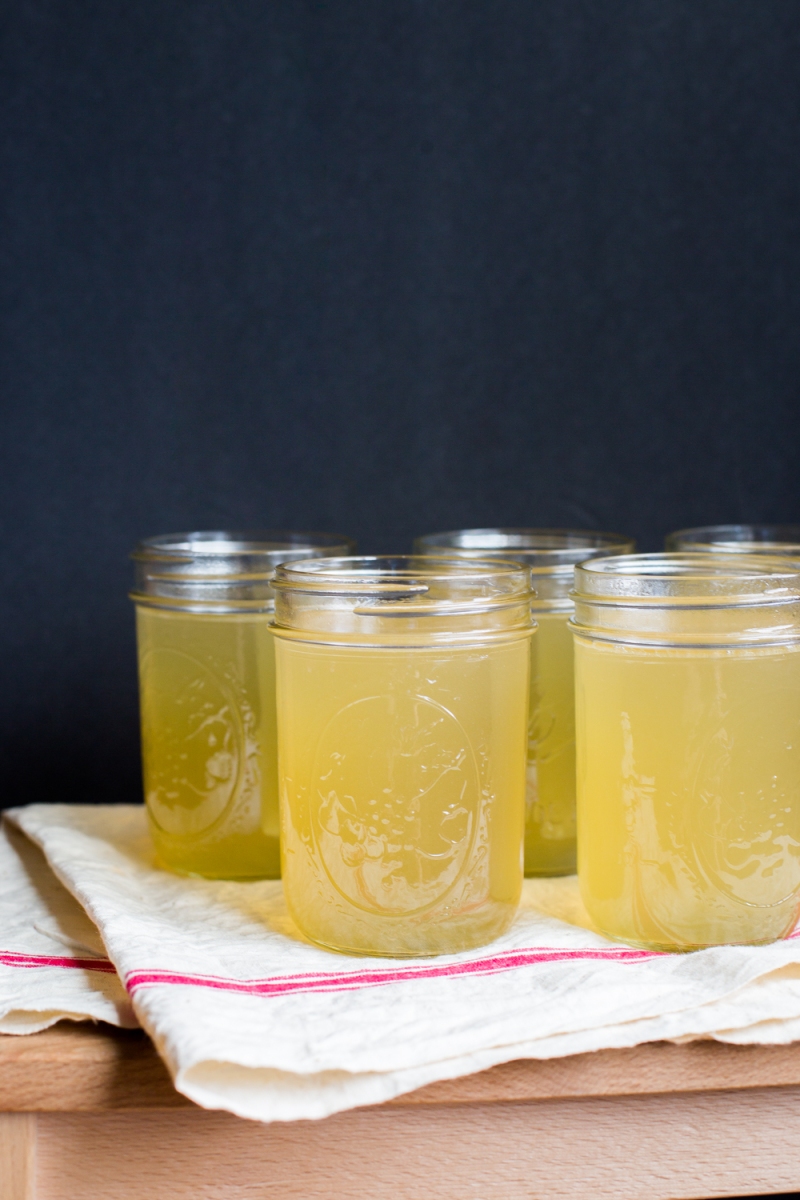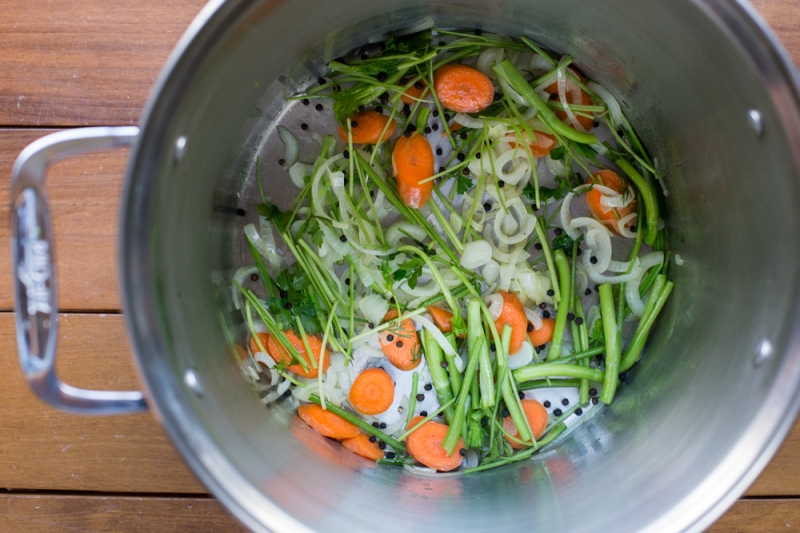
There are two types of people: those who make stock all the time and don’t need or want someone else to tell them how to do it, and those who are intimidated by the process and never start in the first place. The other day, when writing my Blue Crab and Chipotle Bisque recipe, I realized that simply calling for fish stock was a little mean to the latter group, since they might not have some fish stock handy. Honestly, it was a little negligent of me to have this blog for over four years and not post a fish stock guide – after all, what if it was the only thing stopping you from making my delicious Brudet recipe?
One thing in particular I like about fish stock is that it’s surprisingly cheap to make. For example, most fish markets will give you their unused fish heads for free or super cheap. Additionally, I find that the best herbs for making stock are actually the stems of fresh herbs, which means you can save the actual herbs for other cooking creations. Fish stock keeps well in the freezer; we tend to divide the stock into pint jars and leave them in the freezer until we need them. We often use it to whip up a quick fish-based soup, or to add to risotto or fish curries.

Homemade Fish Stock
2-3 lbs non-oily fish heads and/or bones, gills removed (see note below)
2 tbsp butter or olive oil
1 onion, sliced
2 carrots, sliced
1 handfull dill stems
1 handfull parsley stems
4 bay leaves
1 tsp peppercorns
1 tsp dried tarragon
1 cup white wine
cheesecloth
1. Prep your fish head(s) by removing the gills with a pair of kitchen shears. The gills will be attached to the head on each end; I like to cut the gills right at the joint where they attach. Discard the gills (they give the broth a bad color and an off-tasting flavor).
2. In a large stockpot, warm the butter over medium heat. Add the onions and saute until softened, about 4 minutes, then add the remaining ingredients (minus the wine). Saute until aromatic, about 1 minute, then add the wine; simmer until the liquid has evaporated, about 2 minutes.
3. Add the fish head(s) and enough water to cover the fish by 1″. Bring to a simmer then reduce heat to low. You want a very low simmer – it should only bubble slightly. Simmer for 45 minutes, then strain through four layers of cheesecloth. Divide into jars and use within two weeks, or freeze and use within a few months.
** The best fish for stock are mild, non-oily fish, like cod, halibut, rockfish, or flounder. It’s best to avoid fish like salmon, mackerel, or trout.

Half a rockfish head, with its gills removed.
Other uses for fish stock:
Seafood Stew (Virginia is for Hunter-Gatherers)
Ginger and Lime Fish Soup (Things my Belly Likes)

Excellent recipe – thanks
LikeLike
Love fish stock, but hate making it in my house due to the lingering perfume :) looks yummy
LikeLiked by 1 person
Love this post. I like how there are 2 kinds of people. I’ve done fish stock before. My neighbors aren’t happy about it (tiny nyc apartment), but it’s so worth it.
LikeLike
Don’t fish eyes tend to mud color stews? Or was I given wrong advice?
LikeLike
I have been told this before as well, that you should remove the eyes because they can create a bitter taste. I don’t notice any bitterness when I leave them in, but I do notice when I don’t remove the gills. Fish eyes are high in iodine, DHA, and EPA so I figure whatever possible bitterness they might bring is offset by their nutrition :)
LikeLike
thanks for the link love DM! Gorgeous photography – I don’t know how, but you make dead fish look good :)
LikeLike
I’m not sure I could make this at home. Thought about making garum at home but dont like it that much
LikeLike
Sounds delicious! 45 minutes seems like a short time to me to make stock. When I make beef stock, I tend to have it cooking for a few hours. Is that overdoing it? Or is this specifically when making fish stock – I know you did mention using certain fish specifically to create a milder taste. Looks awesome anyway – thanks for the recipe! And what a lovely picture too hehe.
LikeLike
Mark, you hit the nail on the head – fish stock tends to develop an off flavor after an hour of simmering. 45 minutes tends to be the sweet spot in terms of flavor. Beef and chicken bones are more dense and require a longer cooking time.
LikeLike
In cooking school our chef instructor always said to us that a fish stock cooked too long would be dull. You can also purge the bones by soaking in ice water to get a clearer stock.
I also love to make a glaze by reducing the stock. A small cube of the stuff, plus some zest and/or herbs can do miracles to dress a fish.
I’m in the stock fanatic camp, sorry for the interference…
LikeLike
Could you make this in a crockpot?
LikeLike
Where do you get mason jars you can freeze in? The few times I’ve tried to freeze in jars they break.
LikeLike
Laura, we just use regular mason jars. We make sure that there is a good amount of space in the jar before freezing so that the jars don’t crack when the liquid expands. We haven’t had a cracked jar in the 4+ years we’ve been doing it that way.
LikeLike
I find that the best ones to use are the 500 mL (1/2 pint?) wide-mouth jars. I put 400 mL of liquid in it (more or less an inch from the top) and I’ve never had a broken one.
I find that there is too much wasted space when I use the regular-mouth mason jars (if I fill the jars more than an inch from the “shoulders” of the jar they always seem to break).
LikeLike
I make my fish stock very similarly to yours, but I also save up wild-caught shrimp and lobster shells (and the lobster butter) to add in. A small ratio of salmon bones isn’t bad in my experience — maybe about a tenth of the total bones, heads and shells — but too much will overpower.
LikeLike
I have never tried fish stock so I’ll have to give this one a shot at some point, see where it goes. From what I can see in the pictures, it does look tantalizing to say the least. Thanks for the recipe!
LikeLike
If you leave the brown onion skins on it will give your stock a lovely golden colour and add more nutrition.
LikeLike
I like the idea of drinking form jars :D Fish looks scary…
LikeLike
I have not used glass in a freezer for years. I chill stock or soup or chili and put it in zip freezer bags labeled with black magic marker. Freeze them lying flat. Then you can store them without worry of breakage and without wasting between-container-space in the freezer until you want them.
LikeLike